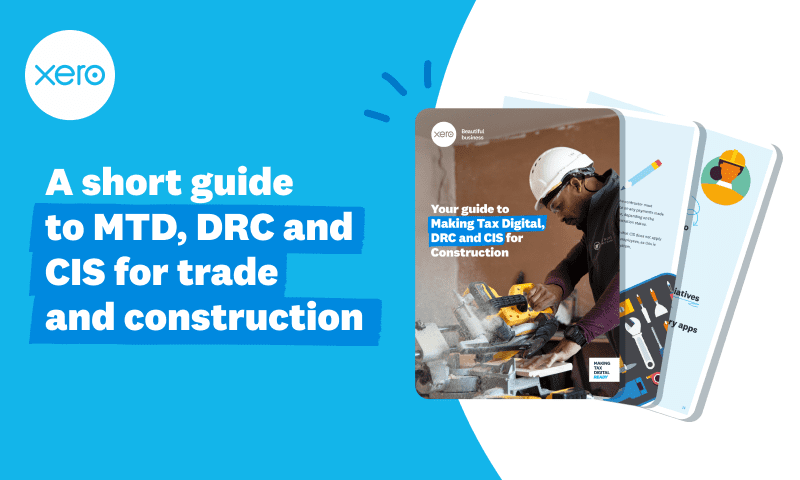
Trade and construction: A short guide to MTD, DRC and CIS


Trade and construction industry workers have faced significant changes over the last few years, from the introduction of Making Tax Digital (MTD) and Domestic Reverse Charge (DRC) VAT to the Construction Industry Scheme (CIS). As a result, many sole traders and business owners have had to adjust their working practices and digitalise their processes.
This short guide will introduce you to MTD, DRC and CIS, with tips on how to comply. For an in-depth look at this legislation, download our full construction industry guide to MTD, DRC and CIS.
Making Tax Digital (MTD)
Making Tax Digital forms part of a wider government initiative to digitise the UK tax system, making it easier to manage your tax obligations.
- From April 2022, MTD for VAT applies to all VAT-registered businesses. This means that VAT-registered businesses must now keep digital records and submit their returns using MTD-compatible software.
- MTD for Income Tax impacts the non VAT-registered self-employed and will apply from 2024, as outlined in this MTD roadmap.
What MTD means for those in the construction industry
If you’re VAT-registered, you’ll need to follow MTD rules from April 2022. If you’re not VAT-registered, you won’t be impacted by MTD for VAT this time, but you will need to comply with MTD ITSA in April 2024, so it makes sense to start digitalising your processes now. Read our MTD guide to find out which rules affect you.
Whether it’s for VAT or Income Tax, you’ll need to start using HMRC recognised software to keep and maintain digital records, along with submitting VAT returns.
Find an MTD compatible software provider now, or talk to your accountant about MTD. You can learn more about the impact of MTD on those in the trade and construction industry in our extensive guide to Making Tax Digital.
Domestic Reverse Charge (DRC)
Domestic Reverse Charge for Building and Construction Services is a method of accounting for VAT. The legislation was introduced by HMRC on 1 March 2021 and applies to all VAT-registered businesses in the UK.
What DRC means for those in the construction industry
In practical terms, DRC means customers (contractors) are now liable for VAT, instead of the supplier (subcontractor).
If you’re providing building and construction services as a subcontractor (supplier) to a CIS and VAT-registered contractor (customer), you don’t need to account for the VAT. Instead, you’ll send them an invoice that shows them the reverse charge.
DRC does not apply when you’re carrying out work for a non VAT-registered customer or end-user (a domestic job in someone’s home, for example). In this instance, you’ll need to account for the VAT yourself.
If you’re a VAT-registered contractor (customer), your invoices will need to include both input and output tax you receive from your VAT-registered subcontractors.
If you’re unsure of how the reverse charge applies to you, check out HMRC’s list of services. You can also learn more about what DRC means in our guide.
Construction industry scheme (CIS)
The Construction Industry Scheme requires that tax be deducted at source from payments made by a contractor or subcontractor. These deductions count towards the subcontractor’s tax and National Insurance.
What CIS means for those in the construction industry
If payments are made under a construction contract between a contractor and subcontractor, both parties need to comply with CIS.
Contractors must register with HMRC before taking on their first subcontractor. Subcontractors need to register for CIS and give their contractor their legal business name and Unique Taxpayer Reference. Deductions are usually 20% but could be 30% for unregistered subcontractors (or if the contractor can’t verify the subcontractor with HMRC).
Under CIS, the contractor deducts tax at source on any payments made to the subcontractor (depending on the subcontractor’s registration status). You can learn more about CIS in our extensive guide.
How Xero can help you comply with MTD, DRC and CIS
Xero accounting software can help you comply with MTD, DRC and CIS legislation. Here’s how:
1. Quote, invoice, and get paid on time
Send customised quotes and invoices with CIS and DRC VAT calculations from your phone. Add a ‘pay now’ button so customers can pay you immediately.
2. Automated calculations
Xero automates your CIS and DRC VAT calculations. You can submit MTD VAT returns directly to HMRC in minutes.
3. Sync with tools of the trade
Xero integrates with construction industry apps including Tradify, Simpro, and ServiceM8, to help you keep track of your jobs and projects from start to finish.
If you want to learn more about how to build a healthy construction business under the new legislation, read our full guide to MTD, DRC and CIS in the construction industry.





